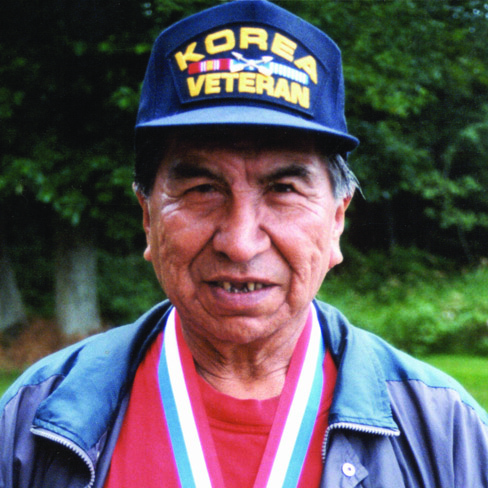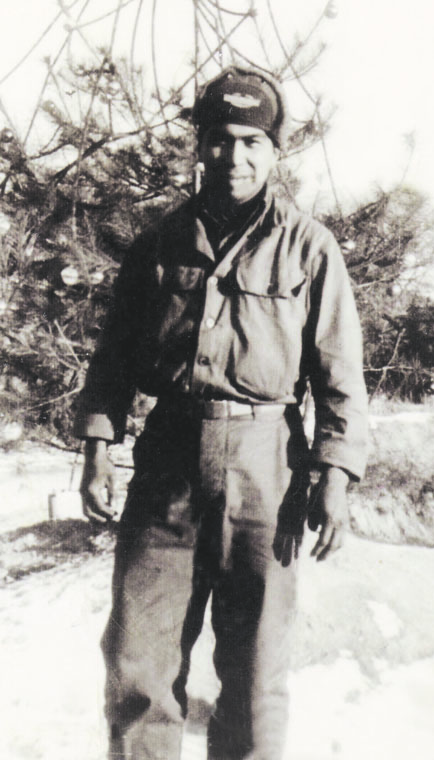
By Sherry Guydelkon, Tulalip News, May 23, 2007
According to tribal elder Ray Moses, before 1957 there were no Memorial Day services at Tulalip cemeteries.
Many families did, however, observe the day by walking to one or both of the reservation cemeteries – Priest Point and Mission Beach – where they would pull weeds and lay flowers on their loved ones’ graves.
They would pack lunches and walk along the Tulalip road, said Ray, gathering wild flowers and greens for wreaths as they walked. People who lived along the road would often offer flowers from their yards. And everyone was careful to leave the cemeteries by three o’clock in the afternoon, because after that time spirits might come out.

By 1957, Ray had returned from the Korean War and was doing his best to stay a little drunk. Jobs for Indian men were hard to come by, and he had plenty of painful wartime memories to blot out.
Finally, his mother Marya Moses let him know that she was concerned that he would drink himself into an early grave. ‘You served your country well,” she said. “You’re a good person when you’re not drinking, but when you drink, you’re no dang good.”
Marya, who had been very supportive of the Tulalip soldiers who fought in Korea and had faithfully written to Tom Gobin, David and Butch Spencer, and others who served there, suggested that he do something useful for the vets.
Then Tom Gobin, who played several instruments, gave him a direction. He said, “If you can get a firing squad, I’ll blow the bugle.”
So Ray talked to Stan Schaefer, who, besides being Marysville’s funeral director, was a member of the VFW, about borrowing rifles one day a year. Stan said that Ray could borrow the Marysville VFW’s rifles, but that they would have to be returned by 11 a.m. for the town’s Memorial Day service.
So Tulalip’s observance was set for 10 a.m., and Ray began gathering his squad together. With a few veterans who became regulars and others that he recruited from the taverns, Ray had his first squad. “They were all willing,” said Ray, “but some of them were weaving a little.”
“I used to tease them,” he said, “and call them the F-Troup after the old comedy TV show. I called Kenny Williams “Dog Tag” and Larry Charley “Crazy Cat” after one of the Indians on the show. And I’d say, ‘Chests in, stomachs out” – the opposite of what they say in the Army. I’d get the guys laughing, sort of lighten things up.’
The only problem was that the rifles were left over from World War I and were defective. Sometimes the ammunition would go off and sometimes it wouldn’t.
“One of the guys asked me, what if my rifle doesn’t fire, what do I do?” Ray recalled. “I said, say bang.”
Regardless of the rifle problems, people were pleased with the bugle and the squad. “The old timers thanked us for honoring our warriors,” said Ray. “And they were warriors. They went off to fight, and they were starting to die at home – Doc Jones, Jack George, Steve Williams, Reuben Shelton, Elliott Brown…
“When our last World War I veteran, Ed Williams, died , I felt bad that there was no bugle there. So we started going to veterans’ funerals, too.”
Encouraged by the responses of the Tulalip families, the squad began traveling to veterans’ funerals at off-reservation communities that had no firing squads of their own – Arlington, Granite Falls, even Tacoma and Olympia. “We had no money and neither did the Tribe,” said Ray, “but George Reeves had a van and people would give us a little money for gas.”
When Clarence Hatch became the Tribes’ business manager in the early 1960s, he and Stan Jones, Sr., agreed that the firing squad should have new rifles, and they were purchased by the Tribes. By then, Tom Gobin had passed the bugle on to Bee Bop Moses, who played in the Marysville High School band. And Clarence even found a little money to pay him.
There was still the problem of buying ammunition, but that was resolved through negotiations with the Marysville VFW. The VFW promised to supply Tulalip’s firing squad with ammo if Ray would march with them in the Strawberry Festival parade. So, for several years, Ray marched for ammo.
Since the new rifles did not have to be returned by eleven o’clock, Memorial Day services could be scheduled for both reservation cemeteries – one at 10 a.m. and one at 11 a.m.
“When I started helping at funerals, I really didn’t know what I was doing,” Ray admits. “I had to change as I went along. I had to become more compassionate.
“I’m glad David Fryberg is continuing that work, and I’m glad the Tribe has the veterans’ program. I hope it will continue on.
“In the beginning, we were encouraged by the old timers and the Shaker people, and later on by the families. They’ve appreciated that we are honoring our warriors for their sacrifices.”
In addition to those who did not return from the wars, said Ray, there were those who were physically and emotionally injured and were never the same again – like Steve Williams who was shot in the leg and P.O.W. Jack George. Ray believes it is only right that the Tribes show our past vets the gratitude that they have earned.
